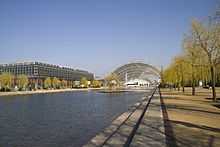Leipzig Trade Fair


The Leipzig Trade Fair (German: Leipziger Messe) was a major fair for trade across Central Europe for nearly a millennium. After the Second World War, its location happened to lie within the borders of East Germany, whereupon it became one of the most important trade fairs of Comecon and was traditionally a meeting place for businessmen and politicians from both sides of the Iron Curtain.
History
The history of the Leipzig fairs goes back to the Middle Ages. A fair held at Leipzig is first mentioned in 1165. In 1190 Otto the Rich, margrave of Saxony instigated two trade fairs in Leipzig, at Easter (Jubilate) and Michaelmas. No other fair was to be held up to a mile away (Marktbann), and the bridges and streets were freed from toll. The Michaelmas fair was held at the church of St. Nikolai, built in 1176. At this time, there were fairs at other Saxon towns like Freiberg, Leisnig, Pegau and Regis as well. In 1268 all foreign merchants travelling to or living in Leipzig got safe conduct for their persons and their goods, even if their Rulers were at war with Saxony. This led to the settlement of numerous merchants in Leipzig. Trade goods now included herring, cloth, wine and pepper.
In 1380, Leipzig got the privilege to force all passing merchants to offer their goods for sale (Stapelrecht). A third fair, at the first of January was founded by Friedrich II of Saxony (the Gentle) in 1458. It had an Imperial privilege.
In 1507 Emperor Maximilian I made the Leipzig fairs imperial fairs (Reichsmessen) and banned any fairs within a 15-mile radius around the town, which further increased Leipzig's importance. Towns like Halle, Naumburg, Erfurt and Magdeburg now became dependent on the Leipzig trade.
In 1523, the Augsburg merchant family Welser built a big house with shops at the Markt 8 (today's Barthels Hof), the rival Fuggers had factories as well.
In the 18th century, Leipzig became the centre for trade with Polish and English goods. It was called 'the marketplace of all Europe'. In 1678/87, a stock exchange was built (Alte Handelsbörse, Naschmarkt, destroyed in 1943, rebuilt).
The importance of the fair, which drew merchants from across Europe, was the impetus for the construction of one of Europe's most significant Moorish Revival buildings, the 1855 Leipzig synagogue by architect Otto Simonson.
In 1895, the old Jubilate-fair was replaced by the modern "Muster-Messe", dominated by factory owners presenting samples of their goods. 30 fair-houses (Messe-Häuser) were built in the years leading up to 1917. They normally contained several interconnected courtyards with shops, storage areas and living space (Mädler-Passage, Petershof, Handelshof, Specks Hof, Drei Könige etc.). Leipzig became the main German fair for books and consumer goods. The fair's MM symbol was designed by Erich Gruner in 1917.
In 1920 the technical fairground was opened in the southeast of the town, between Reudnitz and the Monument to the Battle of the Nations. It included 19 pavilions in 1940. Between the wars, the Ring-Messehaus and the Messehaus Bugra were built. During the war, the area of the technical fair was used for military production and partly destroyed by bombs.

In 1946, the first spring fair ('Peace fair') took place. When the GDR joined the RGW (Comecon) in 1950, the fair was used to present the production of the fellow socialist countries. The technical fairground was rebuilt and contained over 50 pavilions.
The Leipzig fair today
In 1996, a new trade fair ground was opened. The Congress Centre Leipzig was also opened, built after designs by Gerkan, Marg and Partners. The old trade fair ground is used for shops, events, supermarkets and figure skating events, although many areas are empty and unused. Today, the most important fairs are the Games Convention, the Leipziger Buchmesse and the Auto Mobil International.
General facts

The new Leipzig Trade Fair was built in 1995, and opened in April 1996. The new fairground consists of six halls: five exhibition halls, which have a size of 20 000 m², and the world largest levitated Glass Hall, designed by Ian Ritchie Architects. The fairground has about 7,000 parking spaces and is accessible by tram, train, bus or car.
Company facts
Leipziger Messe GmbH was founded after the reunification of Germany in the early 1990s. It is owned equally by Saxony and the city of Leipzig. The firm employs about 300 people, working in the parent company and its subsidiaries. There are two people leading the Leipziger Messe GmbH: the CEO is Mr. W. Marzin and the CTO is Mr. J. Rahmen. The subsidiaries are:
- Fairnet (booth construction)
- Show - Sport – Event (event organization)
- Leipziger Messe International (international trade fair organization)
- Maxicom (bringing foreign companies to Germany)
- Leipziger Messe Gastronomie (gastronomical services)
Leipziger Messe GmbH also has about 25 departments abroad, most of which are autonomous.
External links
Coordinates: 51°23′48″N 12°24′10″E / 51.39667°N 12.40278°E